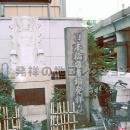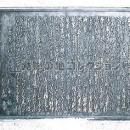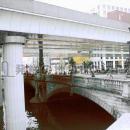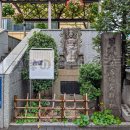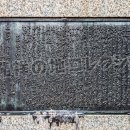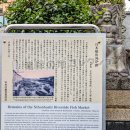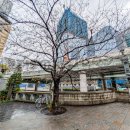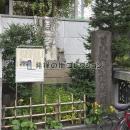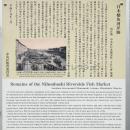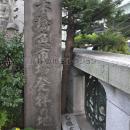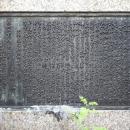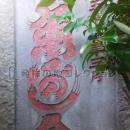日本橋 魚市場 発祥の地
にほんばしうおいちばはっしょうのち
江戸~大正までの期間, このあたりから北 (三越の東側一帯) にかけて 大きな魚市場が 広がっていた。江戸城や大名に納めるための魚の残りを市民に売りさばくことから始まり、にぎわいを見せた。いまでもはんぺん屋やかつお節屋や海苔屋等が居残るなどして、魚市場だった名残がある。
日本橋の北詰 東側、三越前駅駐輪場として使われている小スペース乙姫広場に碑が建っている。昭和29年(1954) に、乙姫(?)モニュメント、昭和55年(1980) に右手前の石柱がそれぞれ設置され、さらに平成19年(2007) に説明板が追加された。
写真
碑文
日本橋魚市場発祥の地
昭和五十五年三月
東京築地魚がし会
本船町小田原町安針町等の間悉く鮮魚の肆なり遠近の浦々より海陸のけぢめもなく鮮魚をこゝに運送して日夜に市を立て甚賑へりと江戸名所圖會にのこれる日本橋の魚市 魚河岸のありしはこのあたりなり旧記によればその濫觴は遠く天正年間徳川家康の関東入国と共に摂津國西成郡佃 大和田兩村の漁夫三十餘名江戸にうつり住み幕府の膳所に供するの目的にて漁業營みしに出づその後慶長のころほひ幕府に納めし残餘の品を以てこれを一般に販売するに至り漁るもの商ふものゝ別おのづからこゝに生じ市場の形態漸く整ふさらに天和貞享とすゝみて諸國各産地との取引ひろくひらけ従ってその入荷量の膨張驚くべきものありかくしてやがて明治維新の変革に堪へ大正十二年関東大震災の後をうけて京橋築地に移転せざるの止むなきにいたるまでその間じつに三百餘年魚河岸は江戸及び東京に於ける屈指の問屋街としてまた江戸任侠精神発祥の地としてよく全國的の羨望信頼を克ちえつゝ目もあやなる繁榮をほしいまゝにするをえたりすなはちこゝにこの碑を建てる所以のものわれらいたづらに去りゆける夢を追ふにあらずひとへに以てわれらの祖先のうちたてたる文化をながく記念せんとするに外ならざるなり
東京に江戸のまことの
しぐれかな昭和二十九年三月
旧日本橋市場関係者一同に代わりて
日本芸術院会員 久保田万太郎 撰
日本芸術院会員 豊道慶中 書
日本橋魚河岸跡
所在地 中央区日本橋室町一丁目八番 地域
日本橋から江戸橋にかけての日本橋川沿いには、幕府や江戸市中で消費される鮮魚や塩干魚を荷揚げする「魚河岸」がありました。ここで開かれた魚市は、江戸時代初期に佃島の漁師たちが将軍や諸大名へ調達した御膳御肴の残りを売り出したことに始まります。この魚市は、日本橋川沿いの魚河岸を中心として、本船町・小田原町・安針町(現在の室町一丁目・本町一丁目一帯)の広い範囲で開かれ、大変なにぎわいをみせていました。
なかでも、日本橋川沿いの魚河岸は、近海諸地方から鮮魚を満載した船が数多く集まり、江戸っ子たちの威勢の良い取引が飛交う魚市が立ち並んだ中心的な場所で、一日に千両の取引があるともいわれ、江戸で最も活気のある場所の一つでした。
江戸時代より続いた日本橋の魚河岸では、日本橋川を利用して運搬された魚介類を、河岸地に設けた桟橋に横付けした平田舟の上で取引し、表納屋の店先に板(板舟)を並べた売場を開いて売買を行ってきました。
この魚河岸は、大正十二年(一九二三)の関東大震災後に現在の築地に移り、東京都中央卸売市場へと発展しました。
現在、魚河岸のあったこの場所には、昭和二十九年(一九五四)に日本橋魚市場関係者が建立した記念碑があり、碑文には、右に記したような魚河岸の発祥から移転に至るまでの三百余年の歴史が刻まれ、往時の繁栄ぶりをうかがうことができます。平成十九年三月
中央区教育委員会
Remains of the Nihonbashi Riverside Fish Market
Location: Area around 8 Muromachi 1-chome, Nihonbashi, Chuo-ku
Fresh fish and other seafood for consumption in the capital were unloaded for three centuries at the market that operated along the bank of the Nihonbashi River between the Nihonbashi and Edobashi bridges. The Nihonbashi Riverside Fish Market originated in the early Edo period as a sales point for fish left over from the supplies sent to the shogun and daimyos lived in Edo castle town by the fishers of Tsukudajima. The riverbank later became the core of a very busy fish trading district sprawling across the Honfuna-cho, Odawaracho and Anjincho neighborhoods (the present Muromachi 1-chome and Honmachi 1-chome area).
The center of activity was the market area along the Nihonbashi River where numerous boats docked, fully laden with fish from nearby coastal waters. Lined with fish shops that throbbed with negotiations in the high-spirited style characteristic of Edoites, with daily transactions totaling as much as a 1000 ryo (equivalent to about 16 kilograms of silver), it was one of the liveliest spots in the city of Edo.
During Edo period, the seafood brought in along the Nihonbashi River was sold to dealers aboard the hiratabune (flatboats) pulled up to the wharf along the riverbank, then displayed on stands at shops on the street side of the riverbank warehouse buildings for sale to the food trade.
When Tokyo was rebuilt after the Great Kanto Earthquake of 1923, the market was relocated to Tsukiji on the Sumida River, and the Tsukiji Fish Market of Tokyo Metropolitan Central Wholesale Market continues to flourish as the city's seafood wholesaling center.
As a reminder of the prosperous trading era of this site, a historical monument was erected in 1954 by people who had been affiliated with the old market, with a summary of the more than 300 years of history from the founding to the relocation of the Nihonbashi Riverside Fish Market.March 2007
Chuo-ku Board of Education
